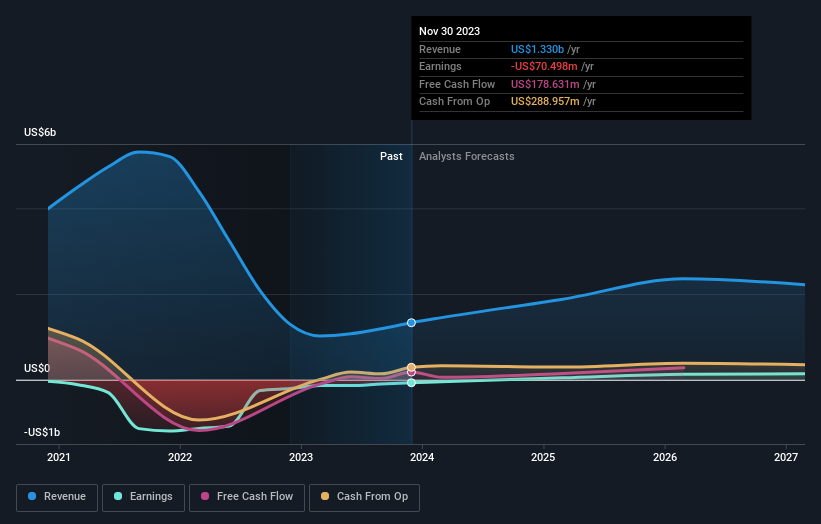key insights
To understand who really controls TAL Education Group (NYSE:TAL), it's important to understand the ownership structure of the business. Institutional investors hold the largest stake in the company, holding his 39% of the shares. That is, if the stock price rises, the group will gain the most (or if the stock price falls, it will suffer the maximum loss).
Losing money on an investment is never fun for shareholders, especially institutional investors whose holdings fell 9.7% last week. However, the blow may have been softened by the company's 98% return to shareholders over the year. But they are probably wary of future losses.
Let's take a closer look to see what the different types of shareholders can tell us about TAL Education Group.
Check out our latest analysis for TAL Education Group.

What does institutional ownership tell us about TAL Education Group?
Institutional investors commonly compare their own returns to the returns of a closely followed index. So they usually consider buying larger companies that are included in the relevant benchmark index.
We can see that TAL Education Group does have institutional investors. And they own a significant portion of the company's stock. This suggests some credibility among professional investors. But we can't rely on that fact alone because institutions make bad investments sometimes, just like everyone does. If multiple financial institutions change their view on a stock at the same time, you could see the stock price drop fast. It is therefore worth checking TAL Education Group's earnings history, below. Of course, what really matters is the future.

TAL Education Group is not owned by hedge funds. CEO Bangxin Zhang holds 27% of the shares, making him the largest shareholder. For context, the second largest shareholder holds about 4.2% of the shares outstanding, followed by an ownership of 3.0% by the third largest shareholder. Interestingly, the second largest shareholder, Yachao Liu, also serves as the Chief Operating Officer, indicating strong insider ownership among the company's top shareholders.
If we take a closer look at our ownership numbers, we can see that the top 12 shareholders have a combined ownership of 51%, meaning that no single shareholder has a majority.
While it makes sense to study institutional ownership data for a company, it also makes sense to study analyst sentiments to know which way the wind is blowing. There are plenty of analysts covering the stock, so it might be worth seeing what they are predicting.
Insider ownership of TAL Education Group
The definition of an insider may vary slightly from country to country, but members of the board of directors are always considered. Management ultimately answers to the board. However, it is not uncommon for managers to be members of the board of directors. This is especially true if the manager is the founder or CEO.
I generally consider insider ownership to be a good thing. However, in some cases, it may be more difficult for other shareholders to hold the board accountable for decisions.
Our information suggests that insiders own a significant stake in TAL Education Group. Insiders own US$2.3b worth of shares in the US$7.4b company. That means a lot. It's good to see this level of investment. Here you can see if insiders have been buying recently.
Open to the public
The general public (usually retail investors) owns 30% of TAL Education Group's shares. Although this size of ownership is significant, it may not be enough to change company policy if the decision is not aligned with other large shareholders.
Next steps:
While it is well worth considering the different groups that own a company, there are other factors that are even more important.
I like to dive deeper Analyze how a company has performed in the past.You can access this interactive graph Check past earnings, revenue, and cash flow for free.
If you want to know what analysts are predicting in terms of future growth, don't miss this free Report on analyst forecasts.
Note: The numbers in this article are calculated using data from the previous 12 months and refer to the 12-month period ending on the last day of the month in which the financial statements are dated. This may not match the full year annual report figures.
Valuation is complex, but we help make it simple.
Please check it out TAL Education Group Could be overvalued or undervalued, check out our comprehensive analysis. Fair value estimates, risks and caveats, dividends, insider trading, and financial health.
See free analysis
Have feedback on this article? Curious about its content? contact Please contact us directly. Alternatively, email our editorial team at Simplywallst.com.
This article by Simply Wall St is general in nature. We provide commentary based on historical data and analyst forecasts using only unbiased methodologies, and articles are not intended to be financial advice. This is not a recommendation to buy or sell any stock, and does not take into account your objectives or financial situation. We aim to provide long-term, focused analysis based on fundamental data. Note that our analysis may not factor in the latest announcements or qualitative material from price-sensitive companies. Simply Wall St has no position in any stocks mentioned.


